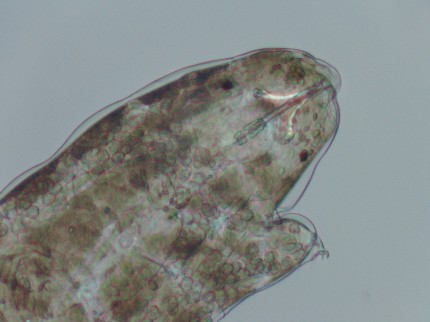School of Hard Science – Indomitable ‘water bear’ more than a curiousity
February 3, 2014 9:10 pm Leave your thoughtsPhoto courtesy of Dr. Aparna Palmer and Chris Watry
Johann Goeze named the tardigrade, discovered in 1773, after its basic appearance.
“Strange is this little animal, because of its exceptional and strange morphology and because it closely resembles a bear in miniature,” he said of the creature. “That is the reason why I decided to call it little water bear.”
Dr. Aparna Palmer, professor of Biology at CMU, is currently conducting a detailed analysis of these tardigrades along with her research students. While tardigrades are known to live in an aquatic environment, they are quite common in the desert of western Colorado and southern Utah.
“That’s kind of puzzling because it is not an aquatic environment, but then again, when you think about it, it can be,” Palmer said.
In Colorado, there are two species that are prominent, one white and the other bright red, which Palmer likes to refer as “the red devil.” While she and her research team only study about one to two square inches of moss at a time, there are records of finding over two million in a square meter.
“In the brief periods of time that we do get rain in the desert, about 14 inches of rain per year, or the times where there is a little bit of snow melt, these animals can actually have an aquatic habitat right there in the moss,” she said.
Tardigrades are close relatives of insects, but they do not quite fit the criterion of them.
“We have phylum Chordata, which you and I are in, then we have phylum Anthropoda, which includes the insects and their relatives. [Tardigrades] are in their own phylum,” Palmer said.
These odd creatures are classified as extremophiles, which means that they can survive in extreme temperatures and pressures that are otherwise lethal to most organisms.
“When it’s dry, obviously they need some way to protect themselves. They’re really remarkable because they can roll themselves into a ball, lose over 90 percent of their water and then go into a dormancy,” Palmer said. Rolling up into a ball, known as a tun, grant the tardigrades protection from harsh conditions.
Chris Watry, a junior biology major working closely with Palmer on her tardigrade research, collects and rehydrates local mosses. Once rehydrated, the tardigrades in the moss migrate to the water in the petri dish. From there, he extracts the water and examines it under a microscope.
Watry has been working on this project for four semesters now.
“I got involved through a friend that asked if I wanted to join her in studying water bears,” Watry said.
Both he and Palmer are very excited to depart Colorado in a couple weeks to continue their research abroad in Italy.
“He’s worked really hard, and he’s worked pretty independently, and he’s done a great job,” Palmer said. “[Chris] is going to travel with me to Italy to learn research techniques from one of the top people in the field of tardigrades.” Watry will be there for a week, and Dr. Palmer will be there for a month.
Palmer works with an average of four to five students on her research projects. Besides the tardigrades, she researches the genetics of marine worms that live on the coast of Oregon and Washington and the genetics of a genus of tropical plants called piper.
As for Palmer’s research into these little water bears, the future looks bright. “I see us characterizing potentially new species,” Palmer said.
ceaconno@mavs.coloradomesa.edu
Tags: Biology, Colorado Mesa University, Dr. Aparna Palmer, Special Section, Tardigrade, Water BearCategorised in: Features
This post was written by critedev

